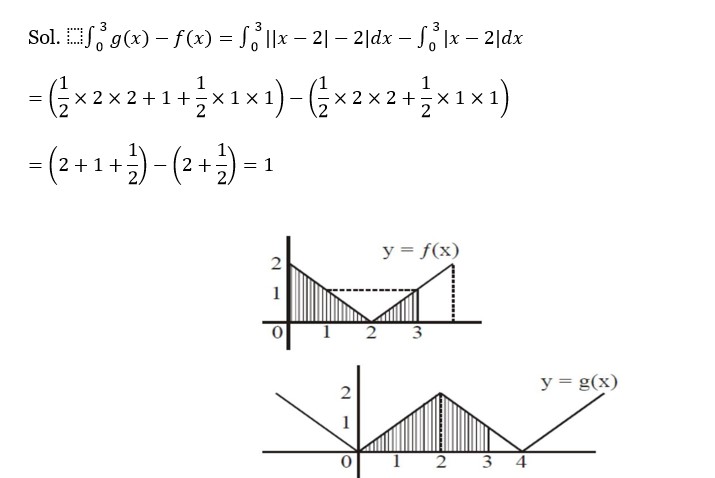Definite Integrals
Get insights from 36 questions on Definite Integrals, answered by students, alumni, and experts. You may also ask and answer any question you like about Definite Integrals
Follow Ask QuestionQuestions
Discussions
Active Users
Followers
New answer posted
3 months agoContributor-Level 10
I = ∫? ² (x³+|x|)/ (e|x|+1) dx . (i)
I = ∫? ² (x³+|x|)/ (e? |x|+1) dx . (ii)
= ∫? ² |x| dx = 2∫? ² x dx
= [x²/2]? ² = (16/4 + 4/2) - 0
= 4+2=6
New answer posted
3 months agoContributor-Level 9
f (x) + f (x + 1) = 2 (1)
replace x with x + 1: f (x + 1) + f (x + 2) = 2 (2)
(2) - (1) ⇒ f (x + 2) = f (x)
∴ f (x) is periodic with period 2.
I? = ∫? f (x)dx = 4 ∫? ² f (x)dx.
I? = ∫? ³ f (x)dx = ∫? f (u-1)du. Let u = x+1.
I? = ∫? f (x-1)dx = 2 ∫? ² f (x-1)dx.
From (1), f (x-1) + f (x) = 2.
I? + 2I? = 4∫? ² f (x)dx + 2 (2∫? ² f (x-1)dx) = 4∫? ² f (x)dx + 4∫? ² (2 - f (x)dx
= 4∫? ² (f (x) + 2 - f (x)dx = 4∫? ² 2 dx = 4 [2x] from 0 to 2 = 16.
New answer posted
3 months agoContributor-Level 10
Answer given by NTS is (1) which is wrong.
I = 1/ (a+b) ∫? x [f (x) + f (x+1)]dx . (1)
Using the property x → a + b - x
I = 1/ (a+b) ∫? (a+b-x) [f (a+b-x) + f (a+b+1-x)]dx
Given f (a+b+1-x) = f (x)
I = 1/ (a+b) ∫? (a+b-x) [f (x+1) + f (x)]dx . (2)
Adding (1) and (2):
2I = 1/ (a+b) ∫? (a+b) [f (x) + f (x+1)]dx
2I = ∫? [f (x) + f (x+1)]dx
2I = ∫? f (x)dx + ∫? f (x+1)dx
Let x+1 = t in the second integral, so dx = dt.
When x=a, t=a+1. When x=b, t=b+1.
∫? f (x+1)dx = ∫? ¹ f (t)dt = ∫? ¹ f (x)dx
New answer posted
3 months agoContributor-Level 10
P (x) = x² + bx + c.
Given ∫? ¹ P (x) dx = 1.
∫? ¹ (x² + bx + c) dx = [x³/3 + bx²/2 + cx] from 0 to 1 = 1/3 + b/2 + c = 1.
2 + 3b + 6c = 6 => 3b + 6c = 4 - (i)
When P (x) is divided by (x-2), the remainder is 5. So, P (2) = 5.
(2)² + b (2) + c = 5 => 4 + 2b + c = 5 => 2b + c = 1 - (ii)
From (ii), c = 1 - 2b. Substitute into (i):
3b + 6 (1 - 2b) = 4
3b + 6 - 12b = 4
-9b = -2 => b = 2/9.
c = 1 - 2 (2/9) = 1 - 4/9 = 5/9.
We need to find 9 (b+c).
9 (2/9 + 5/9) = 9 (7/9) = 7.
New answer posted
3 months agoContributor-Level 10
Find the number of solutions for 2tan(x) = π/2 - x in [0, 2π].
This is equivalent to finding the number of intersection points of the graphs y = tan(x) and y = (π/4) - x/2.
Let's sketch the graphs:
y = tan(x) has vertical asymptotes at x = π/2, 3π/2.
y = (π/4) - x/2 is a straight line with a negative slope.
At x=0, y=π/4.
At x=π/2, y=0.
At x=π, y=-π/4.
At x=2π, y=-3π/4.
By observing the graphs, there will be one intersection in (0, π/2), one in (π/2, 3π/2), and one in (3π/2, 2π].
Total number of solutions is 3.
New answer posted
3 months agoContributor-Level 10
The equation of a plane parallel to x - 2y + 2z - 3 = 0 is x - 2y + 2z + λ = 0.
The distance from the point (1, 2, 3) to this plane is 1.
|1 - 2 (2) + 2 (3) + λ| / √ (1² + (-2)² + 2²) = 1
|1 - 4 + 6 + λ| / √9 = 1
|3 + λ| / 3 = 1
|3 + λ| = 3
3 + λ = 3 or 3 + λ = -3
λ = 0 or λ = -6.
New answer posted
3 months agoContributor-Level 10
I = ∫ from -π/2 to π/2 (1 / (1+e^ (sin x) dx
I = ∫ from -π/2 to π/2 (e^ (sin x) / (1+e^ (sin x) dx
2I = ∫ from -π/2 to π/2 1dx ⇒ I = 1/2 ∫ from -π/2 to π/2 dx
I = 1/2 [x] from -π/2 to π/2 ⇒ I = π/2
New answer posted
3 months agoContributor-Level 10
f (x) = ∫ (from 1 to 3) (√x dx)/ (1+x)² = ∫ (from 1 to √3) (t⋅2tdt)/ (1+t²)² (put √x = t)
= [ (-t/ (1+t²)] (from 1 to √3) + [tan? ¹t] (from 1 to √3) [Applying by parts]
= (-√3/4 + 1/2) + (π/3 - π/4)
= (-√3+2)/4 + π/12
Taking an Exam? Selecting a College?
Get authentic answers from experts, students and alumni that you won't find anywhere else
Sign Up on ShikshaOn Shiksha, get access to
- 66k Colleges
- 1.2k Exams
- 680k Reviews
- 1800k Answers

